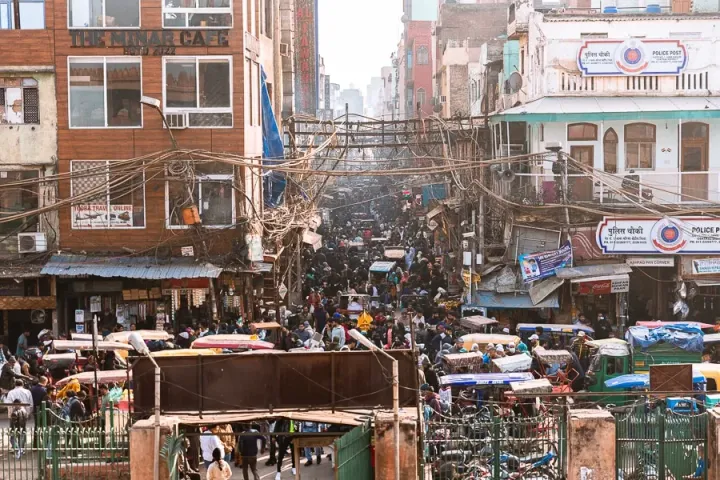Munda Gumbad: A Hidden Gem Among Delhi's Historical Monuments
Delhi is no stranger to historical monuments, with its landscape adorned by structures whose roots burrow deep into the annals of time. Yet, there exist certain sites that languish in relative obscurity, away from the limelight.
One such forgotten monument in Delhi is Munda Gumbad, an undeniable historical structure nestled within the comforting greenery of Deer Park. Dating back to the 15th century, the Munda Gumbad and its surrounding parklands stand as silent reminders of the city's rich past, resonating with traces of history that beg to be explored.
This article will guide you through everything you need to know about visiting Munda Gumbad, from its history and significance to practical details like visiting hours, entry fees, and nearby attractions.
Munda Gumbad: An Unmistakable Historical Structure
Located at the edge of Hauz Khas lake, Munda Gumbad is an intriguing archaeological site in Delhi whose storied past dates back to the 15th century. Its name translates to 'headless dome', owing to its missing dome that was once its crowning glory. This historical structure has seen centuries pass by its side, standing like an old sentinel amidst lush greenery.
The architectural design of Munda Gumbad reflects its Khalji era origins. It sits atop a hillock, commanding panoramic views of the surrounding landscapes. The domeless structure is accessible from all four sides via stairs, adding to its unique charm.
Historically significant yet seemingly forgotten, Munda Gumbad was once considered central to Hauz Khas lake. Believe it or not, it marked the very heart of this vast water reservoir excavated by Alauddin Khalji himself.
The Origins of Munda Gumbad
The history surrounding this archaeological site in Delhi is deeply intertwined with the reigns of two rulers - Sultan Alauddin Khilji and Firoz Shah Tughlaq. During Khilji's reign in 1295 AD, Munda Gumbad was conceptualised as a pavilion built within the expansive Hauz Khas Lake. The lake, also known as Hauz Alai, spanned across 70 acres and was encased by a stone masonry wall.
However, by 1354 CE, under Firoz Shah Tughlaq's reign, the lake was filled up and later cleared out so that it could be replenished annually with water. Tughlaq's efforts ensured the preservation of the lake's historical essence while paving the way for its transformation. Today, Munda Gumbad is situated on the northern edge of the present lake which once formed its epicentre.
Architectural Significance
Munda Gumbad reflects the architectural styles prevalent during its construction period. The monument is square in shape and features horseshoe arches on all sides, allowing passage into its inner chamber. Visitors can also spot traces of a domed pavilion on its roof that once stood tall but now only exists in fragments.
The structure is made up of random rubble, standing strong on a raised platform. The architecture details are an echo of the artistic brilliance of Sultanate era which were further accentuated in each subsequent reign. Unlike the ornate Mughal structures that followed, Tughlaq monuments, including Munda Gumbad, are known for their austere elegance.
While much has changed in Delhi over centuries, the majestic Munda Gumbad has held its ground amidst the city's ever-evolving landscape. Its enduring presence is not only a testament to its solid construction but also to Delhi's mindfulness towards preserving its historical treasures.
Planning Your Visit
Today, Munda Gumbad is fenced off with protective wire to prevent accidents as it watches over Deer Park's scenic vistas - a quiet reminder of Delhi's rich past amongst modernity. However, the surrounding areas and the exterior of the monument itself can be quite a revelation.
Visiting Hours and Entry Fee
Munda Gumbad is located within Deer Park, which is open to the public from sunrise to sunset. There is no separate entry fee to visit Munda Gumbad, as access to Deer Park is free. However, it's advisable to visit during daylight hours to fully appreciate the monument and its surroundings.
How to Reach Munda Gumbad
Munda Gumbad is conveniently located in the Hauz Khas area of South Delhi, making it easily accessible by various modes of transport:
By Metro: The nearest metro station is Hauz Khas, located on the Yellow and Magenta Lines. From the station, you can take an auto-rickshaw or a short cab ride to Deer Park.
By Bus: Several Delhi Transport Corporation (DTC) buses serve the Hauz Khas area. You can alight at the Hauz Khas Bus Terminal and walk or take a short rickshaw ride to Deer Park.
By Taxi/Auto-rickshaw: Taxis and auto-rickshaws are readily available throughout Delhi and can take you directly to Deer Park.
Best Time to Visit
Delhi's climate varies significantly throughout the year. The best time to visit Munda Gumbad is during the cooler months, from October to March, when the weather is pleasant for exploring outdoor sites. Early mornings and late afternoons are ideal for a visit, offering comfortable temperatures and beautiful lighting for photography.
Practical Tips for Visitors
- To fully enjoy your visit, bring a camera for capturing the beautiful surroundings and historical structures.
- Deer Park opens from sunrise to sunset daily; entry is free.
- While there are no specific guidelines for dressing, it's advisable to dress modestly respecting local customs.
- Carry water and some snacks if you plan to spend a few hours exploring.
- If visiting during summers, apply sunscreen and wear hats or use umbrellas for sun protection.
Exploring Munda Gumbad and its Surrounding Areas
Munda Gumbad, with its robust stone structure, invites visitors to step back in time. The monument's simplicity is its charm, showcasing the architectural preferences of the Tughlaq era. As you approach the monument, take a moment to appreciate its historical context and imagine the lives of those who built and used it centuries ago. And don't forget the beautiful park where its situated and its surrounding areas.
Deer Park
Deer Park is Delhi's verdant oasis amidst its urban sprawl. Historically known as Bagh-e-Alam or 'Garden of the World', Deer Park has a rich history that connects it to Sultan Allauddin Khilji's Siri Fort.
In present-day Delhi, the park serves as a mini sanctuary for deers and a recreational space for visitors. It's an oasis of calm where locals seek solace, soaking in the greenery and tranquillity. Deer Park also houses several historical monuments that add a touch of antiquity to its charm.
As you stroll through the park, you'll come across Munda Gumbad standing quietly amidst the greenery, offering a peaceful retreat from the city's hustle and bustle.
Bagh-e-Alam ka Gumbad
Located within the confines of Deer Park stands Bagh-e-Alam ka Gumbad, an impressive monument that echoes the architectural style of the Lodi era. Its red and grey stone edifice, beautifully assembled in an intricate patchwork design, is an arresting sight for any visitor. This archaeological site stands tall as an emblem of 16th-century architecture, complete with arched windows and ornamental detailing that attest to the period's aesthetic sensibilities.
Beyond its architectural grandeur, Bagh-e-Alam ka Gumbad also holds significant historical value. A Persian inscription on its western wall hints at its origins dating back to 1501 AD. Its association with saint Shihab-ud-din Taj Khan adds yet another layer of intrigue to this historical structure.
Walled Mosque
Adjacent to Bagh-e-Alam ka Gumbad lies yet another relic from the past – the Walled Mosque. Flanked by towering octagonal domes on either side, this mosque is a clear testament to Lodi-era aesthetics, featuring five-mehrab niches that point towards Mecca.
The juxtaposition of religious heritage within a natural setting is a unique experience that Deer Park offers its visitors. As you marvel at the intricately-carved arches and the enduring stones of the Walled Mosque, you are also invited to soak in the park's tranquil atmosphere.
Munda Gumbad: Nearby Attractions in Delhi
Hauz Khas Village
Just a short walk from Deer Park is Hauz Khas Village, a vibrant neighborhood known for its eclectic mix of boutiques, art galleries, cafes, and restaurants. The area is built around a medieval reservoir, also known as Hauz Khas, which means "Royal Tank." The juxtaposition of historic ruins and modern establishments makes Hauz Khas Village a must-visit for anyone exploring this part of Delhi.
Safdarjung Tomb
A short drive from Munda Gumbad is the stunning Safdarjung Tomb, an exquisite example of Mughal architecture. Built in 1754, this mausoleum is known for its intricate design and beautiful gardens. The tomb's grand structure and well-maintained surroundings make it a popular spot for history buffs and photographers alike.
Qutub Minar
No visit to Delhi is complete without seeing the iconic Qutub Minar, located about 8 kilometers from Munda Gumbad. This UNESCO World Heritage Site is the tallest brick minaret in the world, standing at 73 meters. The Qutub Minar complex also houses several other historical structures, including the Quwwat-ul-Islam Mosque and the Iron Pillar, making it a comprehensive site for history enthusiasts. This is just one of the manyarchaeologicalsites in Mehrauli that you can visit.
Lodhi Gardens
Lodhi Gardens is another historical park in Delhi, home to several tombs and structures from the Lodhi and Sayyid dynasties. The park's beautifully landscaped gardens and historical domes, such as the Shish Gumbad and Bara Gumbad, make it a favorite spot for both locals and tourists. Like Munda Gumbad, these monuments offer a glimpse into Delhi's rich architectural heritage.
Humayun's Tomb
Located a short drive from Lodhi Gardens, this UNESCO World Heritage site is the tomb of the Mughal Emperor Humayun. It's renowned for its stunning Mughal architecture and beautiful gardens.
Feroz Shah Kotla
Feroz Shah Kotla, another Tughlaq-era monument, is located in central Delhi. This ancient fortress, built by Feroz Shah Tughlaq, includes several intriguing structures, such as the Ashokan Pillar, Jami Masjid, and the Baoli (stepwell). The site offers a deeper understanding of the Tughlaq dynasty's contributions to Delhi's architectural landscape.
Khan Market
Khan Market, one of Delhi's most upscale shopping destinations, offers international visitors a delightful mix of high-end boutiques, trendy cafes, and diverse dining options. Established in 1951, this bustling market is renowned for its vibrant atmosphere and variety of goods, from designer apparel to unique souvenirs. Its central location and cosmopolitan vibe make it a must-visit spot for anyone looking to experience modern Delhi.
India Gate
India Gate, an iconic war memorial in the heart of New Delhi, stands as a tribute to Indian soldiers who lost their lives during World War I. Designed by Sir Edwin Lutyens, this 42-meter-tall archway is surrounded by lush lawns, making it a popular spot for evening strolls and picnics. Illuminated at night, India Gate offers a majestic sight, reflecting the city's rich history and architectural grandeur.
National Museum
Located near India Gate, the National Museum houses an extensive collection of artifacts spanning over 5,000 years of Indian history. It’s a must-visit for history and art enthusiasts.
Reconnect with Indian History
Delhi, with its myriad historical landmarks, is a treasure trove waiting to be discovered. Munda Gumbad is a hidden treasure among Delhi's historical domes, offering a unique glimpse into the city's rich past. As one of the forgotten monuments in Delhi, it provides a serene and educational experience for those willing to venture off the beaten path. Whether you're a history enthusiast, a photography lover, or simply looking for a peaceful spot to explore, Munda Gumbad and its surroundings will not disappoint.
Next time you find yourself in Delhi, take a moment to venture beyond the well-trodden tourist paths. Seek out these lesser-known archaeological sites nestled within verdant landscapes. Exploring Munda Gumbad or taking a leisurely stroll through Deer Park offers not just a refreshing break from the city's bustle, but also a chance to immerse in the fascinating narratives of India's past. So why not take that road less traveled and uncover a slice of Delhi's history as you wander through the quiet corridors of time?




Comments ()